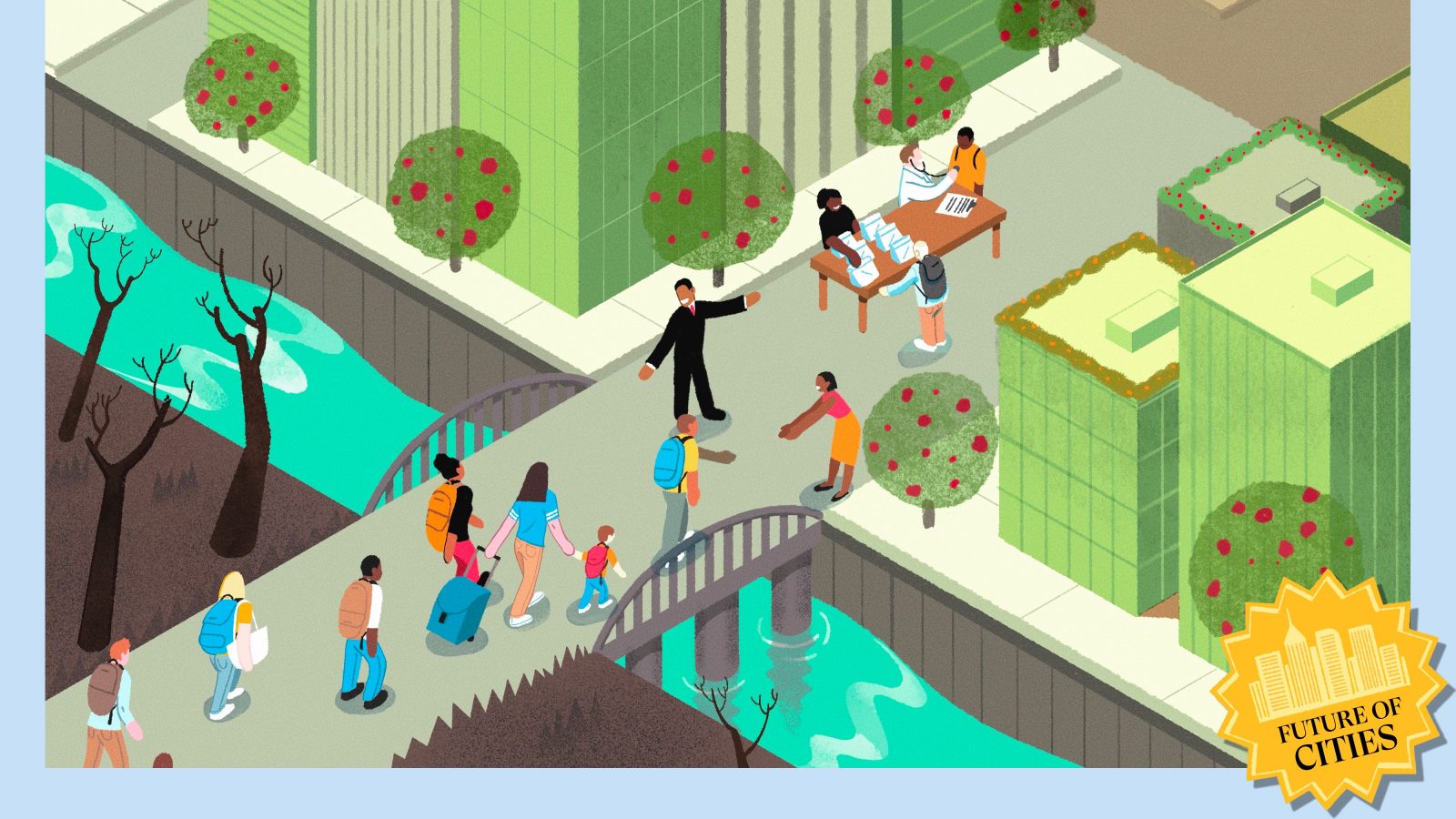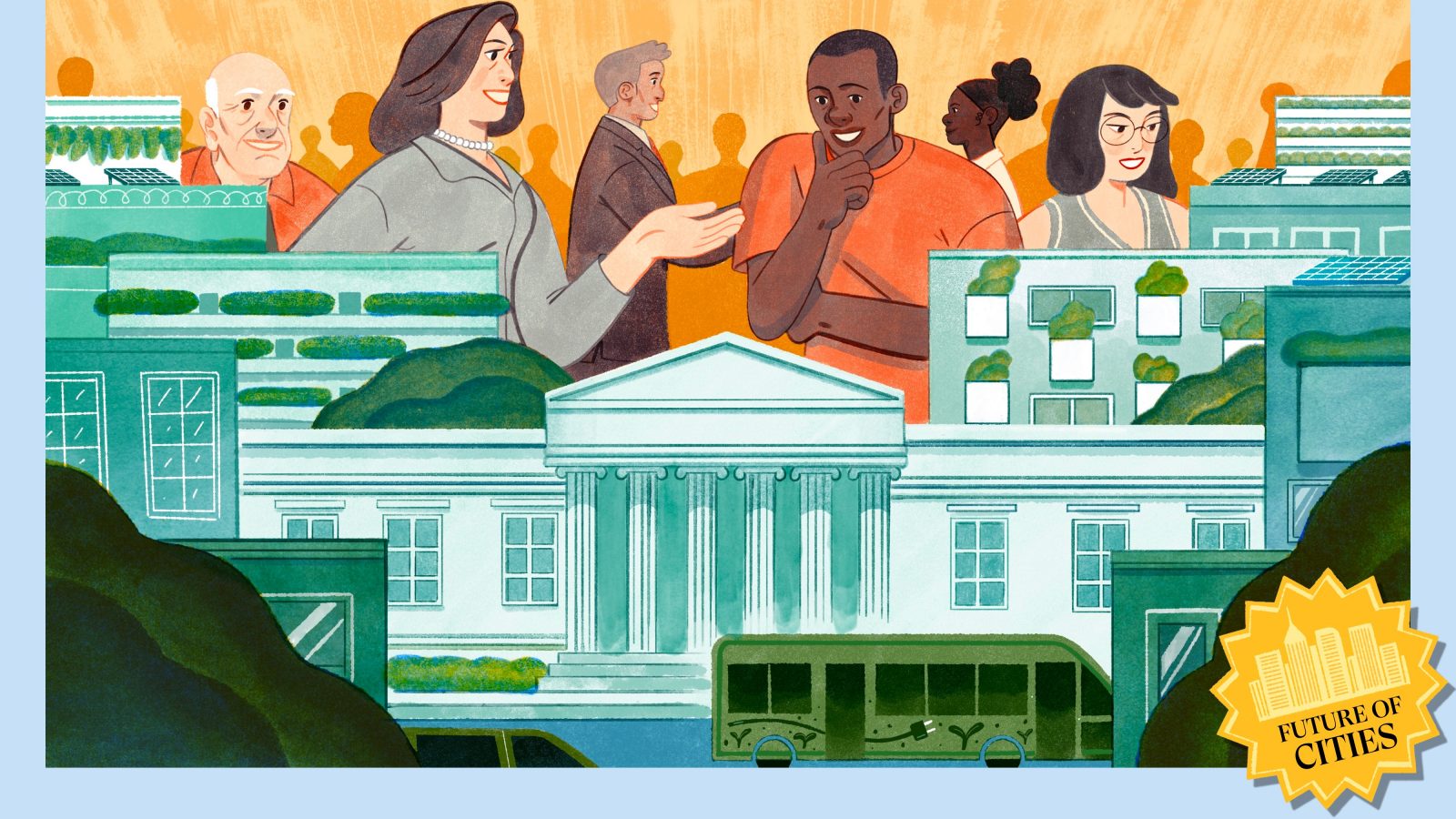As the climate changes, cities must change with it. Fix is exploring how our urban centers are being reimagined and what green, equitable, and resilient communities could look like. With insights from local officials, architects, residents, and more, our Sustainable Cities of the Future series examines how we’ll live, work, and play in the cities of tomorrow. (Explore the full series so far.)
You’re probably familiar with the concept of a go bag. You may have packed, or at least considered packing, a few essentials you could grab in the event of a disaster. But have you thought about where you would go? Would you seek shelter beyond the danger zone and return to rebuild? Would you start over in a new city? A new state? A new country? What about your family, friends, and neighbors?
Such questions will be more than a thought exercise for the 1.2 billion or so people the Institute for Economics and Peace says could face displacement by 2050 due to climate pressures like extreme weather and resource scarcity.
It’s already a reality for millions. Weather events forced more than 10 million people to flee their homes between September 2020 and February 2021, far outpacing those relocating due to conflict. The true number affected by climate is likely much larger, given that the slow onset effects of climate change can drive many other forms of instability — poverty, insurgency, and conflict. “For much of the population who are forcibly displaced, in refugee contexts, climate change is a contributing factor,” says Amali Tower, founder and director of the advocacy organization Climate Refugees.
Preparations to support this growing reality are far behind. One in five displaced people are likely to land on foreign shores. But climate change is not currently a valid reason for seeking refugee status under international law — a statute that dates to 1951 and reflects the geopolitical realities of the time.
Whether it’s within or across national borders, most migrants’ journeys will end in cities. Urban areas house 56 percent of the world’s population (that’s expected to reach 70 percent by 2050), 60 percent of its refugees, and 80 percent of internally displaced people. Outside of planned relocation efforts, it’s difficult to pinpoint which cities will experience the greatest influx, or which places might be hit by disasters that will cause displacement. That, combined with the barriers of working within and around national and international immigration policy, limits the degree to which cities can prepare.
“Denying climate change, or denying that millions of people will migrate because of climate, does not allow for that preparation,” says Thanu Yakupitiyage, a migrants-rights activist who is the U.S. communications director for 350.org (and 2020 Grist 50 honoree).
But as a growing number of cities are making climate-resilience planning a priority in an effort to ensure the safety of current residents, some are also planning for the inevitability of welcoming new ones.
On the ground in a border city
About an hour’s drive from the U.S.–Mexican border sits the city of Las Cruces, New Mexico. In nearby Mesilla, an annual reenactment honors the Gadsden Purchase — which, following the Treaty of Guadalupe Hidalgo, made the final swaths of Arizona and New Mexico a part of the U.S.
“Really, the border crossed us,” says city council member and 2020 Grist 50 honoree Gabe Vasquez. Las Cruces, like much of the Southwest, still shares its cuisine, cultural traditions, and predominant language with its Mexican neighbors. Vasquez says the council ensures that all city information, as well as city-sponsored events and activities, is available in both Spanish and English. Around 60 percent of the city’s population is Latino, and that number, like the city’s overall population, is growing quickly.
People of color and women comprise the majority of the city council, something Vasquez believes is important in setting the tone of who represents the community. He is one of two first-generation Mexican-Americans on the seven-person council. That’s one reason why he says Las Cruces is “very welcoming of immigrants, including undocumented individuals and families — because many of us know the struggle.”
Las Cruces started seeing great influxes of migrants from Central America around 2019, less than a year after the highly politicized migrant caravan arrived in Tijuana, Mexico. Many of these travelers were victims of climate displacement, according to Vasquez. Although most of them were pursuing asylum due to things like gang violence and organized crime in their homelands, the poverty that struck the region was driven in large part by climate change — drought, crop failure, and food insecurity that initially drove people into larger cities at home, then northward. “Their economies have been devastated,” Vasquez says. “Their agricultural production has been devastated and is not likely to recover.”
[Read: From Paris to Phoenix: Why this U.N. climate expert ran for city council]
In April 2019, U.S. Border Patrol started releasing people in Las Cruces daily, leaving them on the streets or at bus stops. Many had “torn clothing, missing shoelaces or other immediate needs,” according to the Las Cruces Sun. Vasquez suspects that Las Cruces was targeted for release because of its status as a welcoming city; the Trump administration had, among other forms of retaliation, threatened to abandon migrants in sanctuary cities. But Vasquez believes Las Cruces lived up to its values in how it handled the influx. With no federal support or program in place, the responsibility to aid and relocate thousands of legal asylum seekers fell to the city.
“We had folks coming into our community by the hundreds,” Vasquez says. “And we welcomed them.”
Vasquez advocated for an “aggressive” resettlement program, which included using a former U.S. Army reserve center to house and feed the newcomers. The program ultimately cost around $2 million. The city cobbled together the funds from its own budget, the majority of which state and federal authorities eventually reimbursed — something that was not guaranteed at the outset.
“We made a decision as a city council to eat the cost if we had to, because it was the right thing to do,” Vasquez says. That money provided medical care, meals, temporary shelter, and travel assistance to close to 20,000 asylum seekers who came through the city.
Most of those people didn’t stay long — only a few hundred remained with host families in Las Cruces. The rest had relatives or connections elsewhere. “Personally, I would welcome any of those folks to stay and be members of our community,” Vasquez says. But whether temporary or permanent, he expects to see more displaced people arrive in his city due to climate factors, and he and his fellow councilors consider Las Cruces’s identity as a welcoming city to be an important part of its climate-resilience plans.
“These two issues are going to continue to be central to who we are as a community,” Vasquez says. “We’ve gone through the tough times, and I think we’re going to come out the better for it.”
The bigger picture
When most people think of “climate” and “immigration,” they think at the global scale — which can be scary. The idea that a changing, increasingly inhospitable climate will drive mass migration is frightening, whether you’re worried about having to leave your own home or about how your home is going to accommodate waves of refugees.
“Immigrants evoke the fear of change,” Yakupitiyage says. And so, of course, does the climate crisis. But migration is, and has always been, a form of adaptation — and it can be a major benefit to receiving communities. “One of the strengths of American cities is how diverse they are,” she says. “Cities very much sustain themselves on immigrant communities.”
Yakupitiyage believes federal and local coordination will be the key to preparing for climate migration, backed by things like emergency funding and job-training programs that can incorporate new arrivals into green economies. She’s not alone: On Earth Day, a coalition of mayors from cities across the U.S. called on President Biden to consult with local leaders when crafting climate-migration policy. Their letter notes that it’s the equitable distribution of city services that enables new residents to thrive. But things like documentation and fear of law enforcement create barriers to people accessing assistance.
Help us imagine the sustainable cities of the future. We want to hear what you’re seeing today that’s exciting, or your biggest ideas for the future.
“You can’t have a country that has a deportation program running at the same time as cities are trying to integrate immigrants,” Yakupitiyage says. “That’s why it’s not just about local sustainability efforts. It’s connected to a broken immigration system that actually needs to factor in climate migrants.”
In Las Cruces, the heavy Border Patrol presence is “a constant source of fear,” Vasquez says, preventing many people from engaging in city activities and offering all that they can bring to the community. This fear can push folks to the fringes, where they may remain in poverty and become victims of environmental injustice in the very places they fled to in order to escape climate-wrought disaster.
“The whole system is ignoring how interconnected all these issues are,” says Tower, who founded Climate Refugees in 2015. “Clearly there’s a need for discussion about how we better protect people when they are forced to seek protection across international boundaries.”
In Bangladesh, for example, experts are advocating for an approach that would make smaller cities and towns more migrant-friendly, easing the flow into the largest urban centers. The preparation would be specific to each locality, but would include things like affordable housing and job creation as well as cultural sensitivity.
Yakupitiyage and Tower argue that countries like the U.S. have an obligation to welcome and support immigrants from the parts of the world that have contributed the least to climate change but are experiencing the brunt of its consequences. Removing language barriers, like Vasquez and his colleagues are doing in Las Cruces, is one important step. Yakupitiyage also cites the IDNYC program in New York, where she is based, as a model. The ID card allows any New Yorker, regardless of immigration status, to access services that require a form of identification. She would also like to see greater efforts to green up the low-income neighborhoods where immigrants tend to live, and job-training programs that could help immigrants become part of the green transition.
“It is entirely possible that more federal investments in renewables and a phase-out of fossil fuels could create millions of jobs, for Americans and for new arrivals,” she says. “We need to make sure that that’s happening, particularly in cities.”
Back in Las Cruces, which is contending with extreme heat, wildfire risk, drought, and flooding, Vasquez says his vision of sustainability prioritizes the basic needs of people — both those who grew up in his community and those who will arrive from elsewhere. For him, a comprehensive sustainability plan means “building a very inclusive city where it’s easy to get around, it’s easy to get assistance, and if you’re an immigrant living in our community, you know that you’re living in a place with clean air, clean water, and access to all those things.”
Explore more in our series on Sustainable Cities of the Future:
>> What big cities can learn about climate adaptation from rural Louisiana
>> Too many clean energy programs leave the poor behind. Enter the ‘equity map.’
>> A more sustainable skyscraper? Imagine a ‘spaceship designed by Jenga.’
>> Why this U.N. climate expert ran for city council
>> What big ideas do you have for the future of cities? Share your thoughts here.




